CRN 30th Anniversary: 10 Computer Ads From The Early 1980s
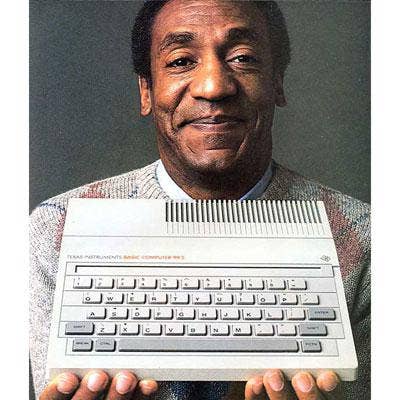
Time Capsules
CRN was launched in 1982, back then it was known as Computer Retail News. As part of our 30th anniversary, we look back at some memorable computer ads from the early days of CRN, like this Texas Instruments' ad featuring Bill Cosby, to see how much things have changed -- from pricing and designs to form factors and brands -- over the last three decades.
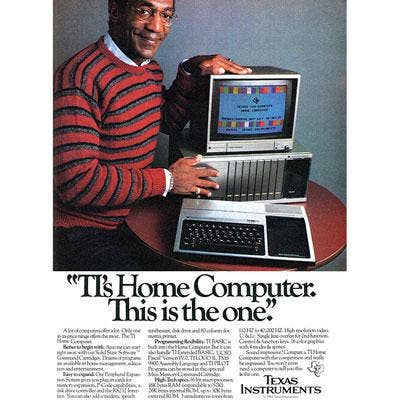
The Cosby Show
In 1982, Texas Instruments hired comedian Bill Cosby as its pitchman. Cosby first pitched the company's new TI/99-4A "Home Computer," which boasted some pretty high-tech specs at that time: a 16-bit microprocessor, 16K of RAM, and 26K of ROM for the modest price of $525.
While Cosby was featured in several more TI ads (as well as ads for Coca-Cola, Jell-O and Kodak), the TI/99-4A was discontinued the following year. Texas Instruments eventually departed the computer-making business but today is one of the largest semiconductor manufacturers in the world.
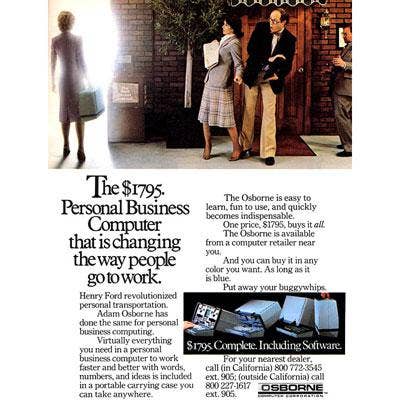
Going Mobile
In 1981 Osborne Computer Corp. released the first commercially available portable computer, dubbed the Osborne-1. And by 1982, the Osborne-1 had taken the world by storm with ads like this one, which compared developer and company founder Adam Osborne to automobile legend Henry Ford.
"Portable" is a relative term, of course. In the earlier 80s, a mobile computer like the Osborne-1 looked like an oversized suitcase that weighed over 20 pounds and had its own fold-out keyboard and 5-inch black-and-green screen. But the real hook for the Osborne-1 was its price: $1795, which included not just the computer and CP/M operating system but a bundle of business programs and office applications as well. Osborne Computer ran into financial issues a few years later and closed down in 1985, but the Osborne-1 started the trend of mobile computing 30 years ago.
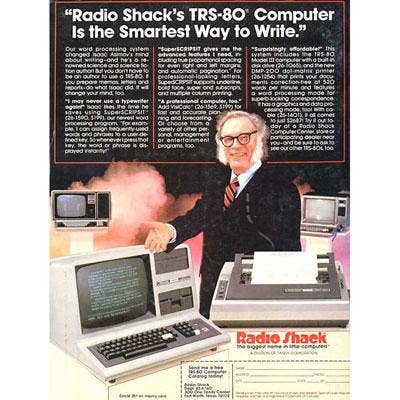
The Sci-Fi Channel
This is one of the most synergistic marriages between a product and a spokesperson. In 1982, Radio Shack tapped author Isaac Asimov, one of the grandmasters of science fiction, to promote its line of new home computers, which at the time must have seemed like science fiction to the average person.
The TRS-80 Model III boasted up to 48K of memory, a 2.03MHz CPU, dual disk drives and an integrated B/W monitor. The base model was priced at $700, but this ad offered a Model III bundled with software and a dot-matrix printer for a cool $2,687.
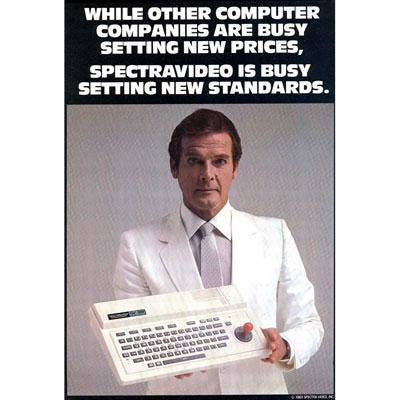
Bond. James Bond.
This 1983 ad for the Spectravideo computer features James Bond actor Roger Moore, who's dressed like Tom Wolfe and holding the Spectravideo SV-318 model.
Spectravideo got its start developing video games for the Atari 2600. After building a computer add-on for the Atari, dubbed CompuMate, the company decided to develop its own stand-alone computers. The SV-318 was the first attempt, and the monitor-less system featured a white keyboard and a red, built-in joystick. While the SV-318 had capable specs -- a 3.58MHz processor and 16KB of RAM -- the odd design made it a tough sell, even with the approval of James Bond. Spectravideo closed down in 1988.
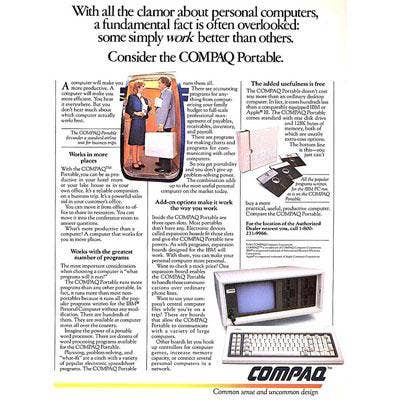
Portable Power
Compaq was born in 1982, and shortly after its launch, the computer maker introduced its first marquee product: the Compaq Portable.
The "luggable" computer weighed almost 30 pounds and was bigger than most of today's carry-on luggage -- just look at the poor guy in the ad. But, it was Compaq's first IBM-compatible PC, and it featured a detachable keyboard, 9-inch green screen monitor and dual floppy disk drives. At $3,590, the Compaq Portable was much more expensive than an Osborne-1 but less pricey than an Apple III or IBM PC.
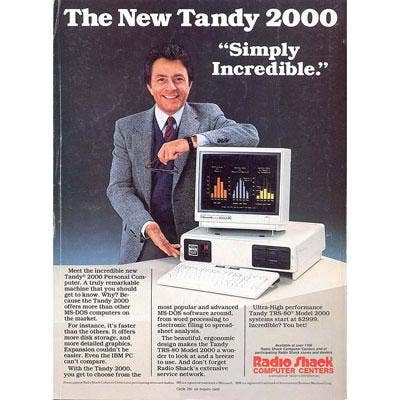
The Incredible PC
Television star Bill Bixby, best known for the "The Incredible Hulk," joined Isaac Asimov as a spokesperson for Radio Shack in 1984.
Bixby appeared in a number of television commercials and print ads promoting the Tandy 2000 personal computer, which was first released in 2003. The Tandy 2000 was similar to the earlier TRS-80 home computers, except this "incredible" PC boasted an 8MHz processor and had more storage than most other PCs on the market. Despite the strong specs and an attractive price tag, around $3,000, the Tandy product line faded and Radio Shack exited the PC business.
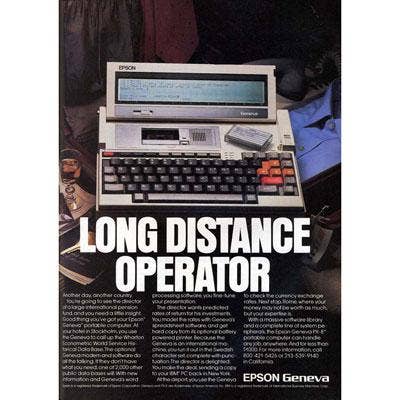
Geneva Convention
We know Epson today primarily for its peripheral products like laser printers and projectors, but the Japanese technology maker had a significant PC business in the early 80s. Take the Epson Geneva PX-8, yet another "portable computer" aimed at traveling business people.
Released in 1984, the Geneva PX-8 was different from other portable computers at the time. For one, the Geneva had a built-in microcassette tape drive for storage, making the computer look like an oversized tape deck. The microcassette drive could also be used to play music or audio recordings. Epson's portable computer had no internal disk drive but cost a mere $995. While the Geneva PX-8 didn't sell well, you can see the beginnings of the traditional notebook PC form factor in its design.
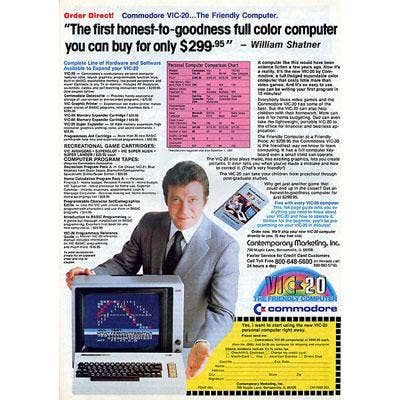
Beam Me Up, VIC
In the early 80s, William Shatner became a pitchman for Commodore Computers. And in 1982, the same year that "Star Trek II: The Wrath of Khan" hit theaters, Captain Kirk himself appeared in a number of TV commercials and advertisements like this one promoting the new, ultra-affordable Commodore VIC-20.
The VIC-20 is considered to be the first low-cost color computer, thanks to its $299.95 price tag and its large color display. The VIC-20 became the best-selling PC in 1982, and it was reportedly the first computer of any kind to sell more than 1 million units. But when Commodore introduced the 1983 Commodore 64, the VIC-20's sales plummeted until the model was discontinued in 1985.
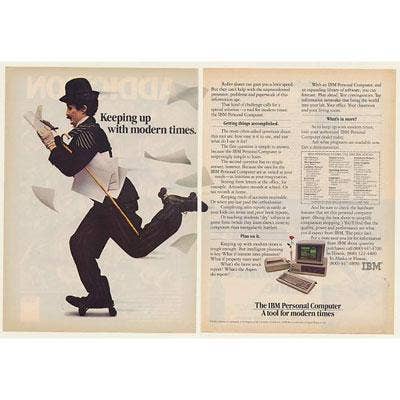
Big Blue's Tramp
We can't have a list of early 80s computer ads without including the original IBM PC, the 5150. Released in 1981, Big Blue began running a series of print advertisements the following year for the 5150 -- as well as other IBM products -- featuring a Charlie Chaplin lookalike doing his best impression of Chaplin's most famous character, "The Tramp."
The 5150 was no tramp, however. IBM's original PC, which started at $1,565, featured a 4.77MHz Intel processor and a minimum of 16KB of RAM. Entry-level versions came with just a tape cassette drive and Microsoft BASIC, while more expensive versions featured dual 5.25-inch disk drives and IBM's PC DOS operating system, as well as a black-and-green display. The IBM 5150, which was eventually discontinued in 1987, is credited with popularizing the PC.
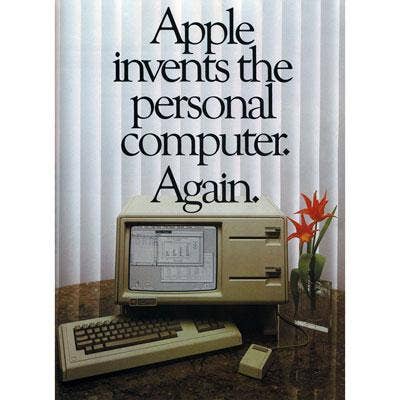
Hello Lisa
Last but not least, we have Apple's Lisa. Released in 1983 at a hefty price tag of $9,995 (some things never change, huh?), Lisa was considered a commercial failure and is remembered by many for one simple reason: Apple moved Steve Jobs off the Lisa development team in 1981, so he joined the Macintosh development team and helped polish the now-famous computer.
The Macintosh's predecessor is noteworthy, too, for being the first commercial computer with a graphical user interface, the Apple Lisa GUI operating system. Despite having advanced features like protected memory, a numeric keypad and a document-centric operating system, Lisa was too expensive for the average user. Nevertheless, the Lisa was an important chapter in Apple's history, and with this ad, you get a taste of the kind of bravado that would become familiar with Apple's marketing.
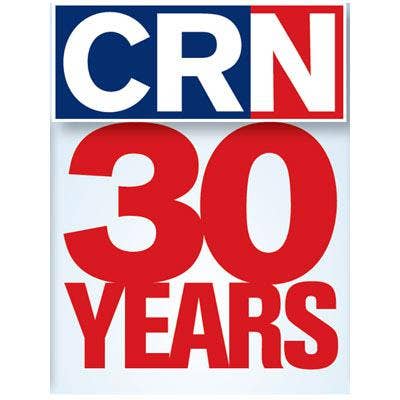
More From CRN's 30th Anniversary
30 Years In The Channel:
CRN's 30th Anniversary
Three Decades Of Tech Startups
Tech Stocks Then And Now